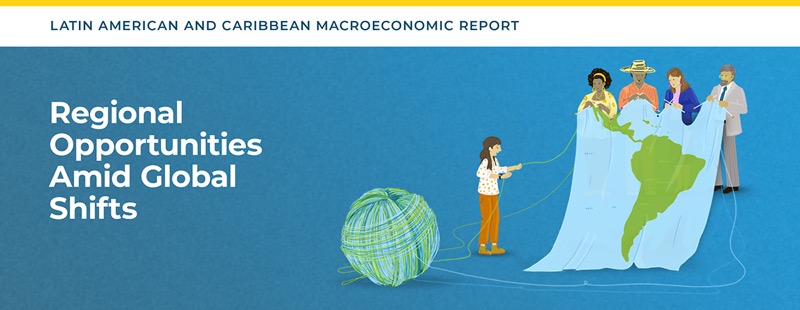
Latin America and the Caribbean can look back on the economic management of the post-pandemic period with some pride. Central banks acted decisively, raising interest rates before other regions and successfully curbing inflation faster. Fiscal balances were consolidated, contributing to lower sovereign debt spreads. Financial markets showed they could withstand shifts in global capital flows, and labor markets in many countries demonstrated remarkable strength, with historically low unemployment levels. GDP growth is projected at 2.2% in 2024 and 2.1% in 2025, marking a return to long-term averages. All these developments have been positive, leading to a period of relative economic stability.
The future, however, remains uncertain. Potential shifts in economic policy by major global economies, including changes in tariffs, add pressure to a scenario characterized by higher global interest rates, high debt levels, and expected slowdowns in the United States and China. The median yield on Latin American and Caribbean sovereign debt has climbed from about 4.7% before the pandemic (December 2019) to about 7.3% in December 2024, imposing significant additional interest costs. Potential drops in commodity prices from increased supply or falling demand represent a risk for the commodity producers and traders of the region.
Meanwhile, food prices remain about 10% higher than the overall consumption basket compared to pre-pandemic levels, exacerbating poverty and amplifying risks to social and political stability.
A Guide to New Opportunities
The challenges for the region arising from this evolving global economic landscape are the focus of the IDB’s 2025 Latin American and Caribbean Macroeconomic Report.
The report examines how the region can leverage the global realignment in trade and investment to boost productivity and resilience. It shows how that can be achieved while addressing structural weaknesses like high labor informality, which affects between 20% and 80% of the workforce across different countries, and persistent fiscal deficits, which deteriorated in over half the region’s countries in 2024.
The report also explores how central banks should calibrate their monetary policies, with special attention to the divergent inflation dynamics across countries with different monetary frameworks. And it analyzes what countries can do to improve resilience to sudden stops in capital flows while evaluating emerging trends like artificial intelligence, which could significantly impact up to 132 million jobs in the region over the next decade.
Strengthening Regional Trade Integration
In the wake of the supply chain disruptions caused by the COVID-19 pandemic, as well as growing trade tensions and geopolitical conflicts, a shifting global landscape has emerged. Tariff adjustments, changing patterns of investment and new trade agreements have created a new order in trade. Yet, while regions like Europe and Asia have strengthened regional value chains and capitalized on nearshoring opportunities, Latin America and the Caribbean remains among the least integrated of regions, with intraregional trade accounting for just 15% of total goods traded, far below Europe’s 68% and Asia’s 55%.
Despite having more than three dozen regional trade agreements, integration remains shallow. Liberalization has largely occurred within rather than across these agreements. This limited integration, the report emphasizes, makes the region more vulnerable to external shocks and reduces opportunities for industrial development and foreign direct investment. Strategic reforms—including harmonizing trade agreements, improving infrastructure, and addressing logistical inefficiencies—could enhance the region’s capacity to develop robust regional value chains and better position it within the shifting global trade environment. A major opportunity would be missed if the region failed to reap those rewards.
Tackling Fiscal Challenges Through Efficiency
A worsening fiscal situation in over half of the region’s countries is another of the report’s concerns, among other reasons because it negatively affects the affordability of debt. This suggests the urgency of greater fiscal consolidation. The report estimates that public sector inefficiencies amount to approximately 4.6% of GDP, with inefficiencies in procurement, public wage premiums, and poorly targeted transfers representing substantial opportunities for improvement.
By addressing these inefficiencies, countries could improve their primary balances by 3.6 percentage points of GDP and decrease public debt by 7.3 percentage points over four to eight years. These measures would also generate a 1.8 percentage point increase in GDP growth through improved resource allocation and productivity. Reducing budget rigidity is important, and the report provides a roadmap for doing so to enable countries to adapt to changing economic conditions while easing fiscal pressures and allowing for countercyclical policy responses.
These are only a few of the areas the report plumbs. Wide ranging examinations also cover potential remedies to the harmful economic effects of the region’s labor informality, encompassing a large share of its labor force; the need in the monetary realm for tailored policy responses to the diverse inflationary pressures in different countries; and the importance of closing fiscal and external gaps and building up reserves and monitoring risks to reduce vulnerability to sudden stops.
Unleashing the Region’s Potential in the New Global Environment
Latin America and the Caribbean has demonstrated resilience in navigating post-pandemic challenges. Yet it is constrained by low growth, limited fiscal space, and increasing social needs. The report underscores that meaningful progress will require seizing opportunities arising from the realignment of global value chains, the rapid advancement of new technologies, and the clean energy transition. With strategic policy reforms focused on boosting intraregional trade, reducing labor informality, enhancing fiscal frameworks, and ensuring prudent monetary management, Latin America and the Caribbean can build foundations for greater prosperity. The path forward requires balancing immediate stabilization needs with long-term structural reforms to unleash the region’s full potential in an increasingly complex global economic environment.


Leave a Reply